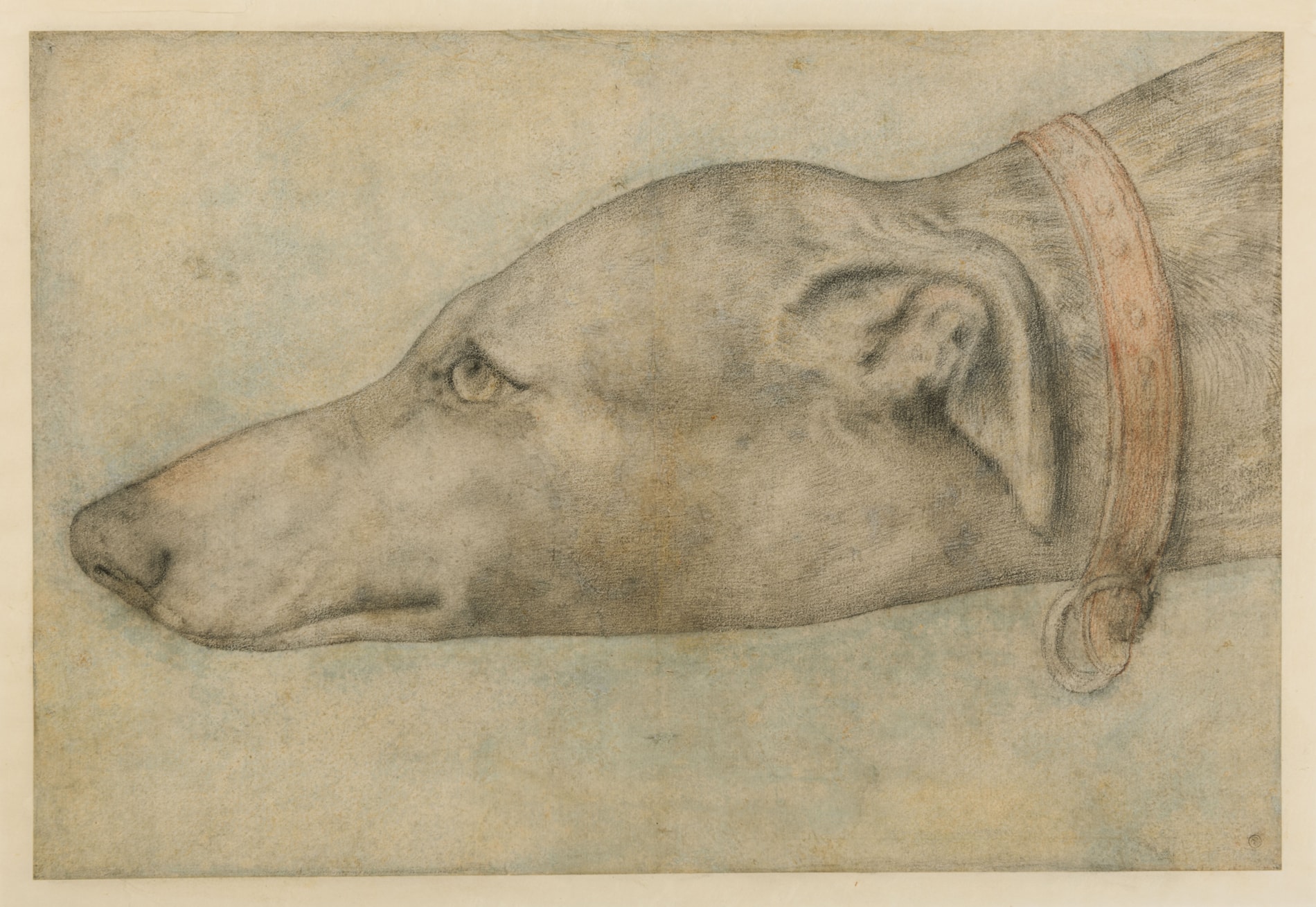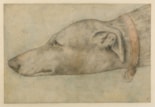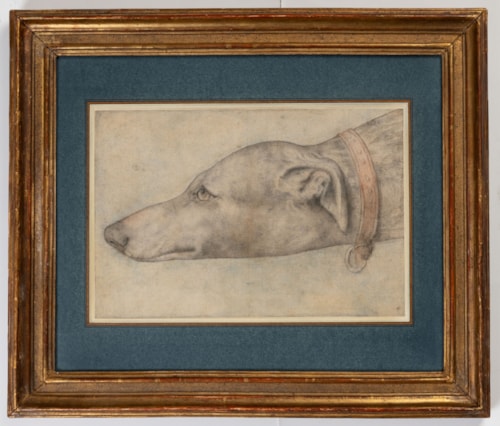Circle of ANTONIO DI PUCCIO PISANO, called PISANELLO
(Verona or Pisa 1394 - Rome or Naples 1455)
Study of the Head of a Greyhound
Sold
Black and red chalk. Laid down.
245 x 363 mm. (9 5/8 x 14 1/4 in.)
245 x 363 mm. (9 5/8 x 14 1/4 in.)
Known for his masterful depictions of animals, Pisanello was, in the words on one scholar, ‘one of the keenest observers and finest delineators of men’s features and animals’ forms that the art of the Western world has produced.’ Many of his surviving drawings, and those of his school, are of animals that appear in larger works. Greyhounds and other hunting dogs are found in a number of Pisanello’s paintings and drawings, such as in the damaged fresco of The Parting of Saint George and the Princess of Silena of c.1434-1438 in the church of Sant’Anastasia in Verona and a highly finished drawing of A Nobleman on a Mule, Hawking with Five Hounds in the Lugt collection at the Fondation Custodia in Paris.
This very fine drawing of a greyhound, of exceptional quality, was long attributed to Pisanello. Indeed, a very similar head of a greyhound appears, albeit in reverse, in the foreground of Pisanello’s small panel painting of The Vision of Saint Eustace, where it is depicted coursing a hare. Probably painted between 1438 and 1442, the painting is today in the National Gallery in London. The Vision of Saint Eustace has been aptly described as ‘Not an altarpiece, not merely a narrative, but a pretext for showing Pisanello’s skill in depicting different animals and for the patron to marvel at their poetic variety and the mystery of the inhabitants of the wooded landscape.’ The position of the head of the hound in the present sheet is nearly identical to that of the dog in the painting, and both animals wear very similar collars.
Among the large corpus of surviving drawings by Pisanello and his circle are several studies of greyhounds and other dogs, some seemingly drawn from life and others taken from model books or copied from the work of earlier artists. These include a number of autograph drawings of greyhounds from the Vallardi album in the Louvre, which also contains drawings of several other breeds by Pisanello. An interesting comparison may also be made with a similar dog that appears in a drawing of three hounds chasing and devouring rabbits from the Vallardi album in the Louvre. Drawn in pen and brown ink with watercolour on vellum, although in a manner somewhat more naïve and much less refined than the present sheet, the Louvre drawing was formerly attributed to Pisanello but is now given to the earlier Lombard painter and illuminator Michelino da Besozzo (c.1370-c.1455). A copy of part of that drawing, by a different hand which is sometimes thought be that of Pisanello himself, was likewise part of the Vallardi album.
Given its undeniable quality, it is unsurprising that this 15th century drawing has long held an attribution to Pisanello, under whose name it was exhibited in Paris in 1932. The naturalistic representation of the muzzle of the greyhound, beautifully drawn in a subtle combination of black and red chalks, has something of the characteristics of a formal profile portrait, characterized by an innate nobility and dignity. The close study of the creature’s nose and ear and intensely focused sharp eye, as well as the finely drawn smooth coat and studded leather collar with a buckle, all point to an artist of considerable skill.
The present sheet is one of two drawings given to Pisanello that were at one time in the collection of the Parisian art dealer Lucien Guiraud (d.1954), and which were lent by him to an exhibition of Pisanello’s work at the Bibliothèque Nationale in Paris in 193213. The drawing had been acquired by Guiraud from the collection of the art historian Charles Molinier (1843-1911) of Toulouse, whose mark it bears. A professor of art history at the University of Toulouse, Molinier began collecting drawings in 1875, acquiring them in Paris and the south of France, as well as in several trips to Italy. On his death his collection was inherited by his children and the drawings gradually dispersed to collectors and dealers, such as Guiraud.
This very fine drawing of a greyhound, of exceptional quality, was long attributed to Pisanello. Indeed, a very similar head of a greyhound appears, albeit in reverse, in the foreground of Pisanello’s small panel painting of The Vision of Saint Eustace, where it is depicted coursing a hare. Probably painted between 1438 and 1442, the painting is today in the National Gallery in London. The Vision of Saint Eustace has been aptly described as ‘Not an altarpiece, not merely a narrative, but a pretext for showing Pisanello’s skill in depicting different animals and for the patron to marvel at their poetic variety and the mystery of the inhabitants of the wooded landscape.’ The position of the head of the hound in the present sheet is nearly identical to that of the dog in the painting, and both animals wear very similar collars.
Among the large corpus of surviving drawings by Pisanello and his circle are several studies of greyhounds and other dogs, some seemingly drawn from life and others taken from model books or copied from the work of earlier artists. These include a number of autograph drawings of greyhounds from the Vallardi album in the Louvre, which also contains drawings of several other breeds by Pisanello. An interesting comparison may also be made with a similar dog that appears in a drawing of three hounds chasing and devouring rabbits from the Vallardi album in the Louvre. Drawn in pen and brown ink with watercolour on vellum, although in a manner somewhat more naïve and much less refined than the present sheet, the Louvre drawing was formerly attributed to Pisanello but is now given to the earlier Lombard painter and illuminator Michelino da Besozzo (c.1370-c.1455). A copy of part of that drawing, by a different hand which is sometimes thought be that of Pisanello himself, was likewise part of the Vallardi album.
Given its undeniable quality, it is unsurprising that this 15th century drawing has long held an attribution to Pisanello, under whose name it was exhibited in Paris in 1932. The naturalistic representation of the muzzle of the greyhound, beautifully drawn in a subtle combination of black and red chalks, has something of the characteristics of a formal profile portrait, characterized by an innate nobility and dignity. The close study of the creature’s nose and ear and intensely focused sharp eye, as well as the finely drawn smooth coat and studded leather collar with a buckle, all point to an artist of considerable skill.
The present sheet is one of two drawings given to Pisanello that were at one time in the collection of the Parisian art dealer Lucien Guiraud (d.1954), and which were lent by him to an exhibition of Pisanello’s work at the Bibliothèque Nationale in Paris in 193213. The drawing had been acquired by Guiraud from the collection of the art historian Charles Molinier (1843-1911) of Toulouse, whose mark it bears. A professor of art history at the University of Toulouse, Molinier began collecting drawings in 1875, acquiring them in Paris and the south of France, as well as in several trips to Italy. On his death his collection was inherited by his children and the drawings gradually dispersed to collectors and dealers, such as Guiraud.
A painter, draughtsman and medallist from Verona, Antonio di Puccio, known as Pisanello, enjoyed a long and highly successful career. He was probably born and grew up in Verona, but nothing is known of his training or early life before 1424, when he appears in a document already described as a ‘distinguished painter’ (‘pictor egregius’), and 1425, when his name is recorded for the first time in the account books of the Gonzaga family in Mantua. Pisanello travelled extensively throughout Italy, working in Verona, Pavia, Rome, Ferrara, Milan, Mantua and Naples. He enjoyed the patronage of some of the most powerful and sophisticated courts in Italy, receiving important commissions from the Gonzaga in Mantua, the d’Este in Ferrara and Alfonso V of Aragon, King of Naples, as well as Filippo Maria Visconti, Duke of Milan, and Popes Martin V, Eugenius IV and Nicholas V. One of the finest medallists in Italy, Pisanello produced a number of striking portrait medallions from the 1430s onwards. Despite his concurrent fame as a painter, however, very few of his paintings have survived to this day. Indeed, only four or five panel paintings and three frescoed mural compositions – two in churches in Verona and the other in the Palazzo Ducale in Mantua, all in poor condition – exist today from his oeuvre as a painter.
As a draughtsman, however, Pisanello is better known. Around four hundred drawings by Pisanello and his workshop are known today, of which by far the largest group is now in the Louvre. (Almost all of the Louvre drawings come from an album acquired by the museum in 1856 from the Milanese print publisher and dealer Giuseppe Vallardi.) The range and variety of extant drawings by Pisanello and artists of his circle allow for a closer understanding of the master’s working methods. When planning a composition, Pisanello ‘would employ his own ‘pattern’ drawings from stock, often very finished and beautiful – drawings above all of birds and animals – and also make new sketches for specific elements for the project in hand…Pisanello would also execute a series of finished studies on a particular theme. These would provide him with a corpus from which he could select one or more drawings to be used in the final painting, and which he could use again as workshop patterns in the future. Such drawings usually represent animals, drawn from life – for example hounds…and, above all, horses.’
As has recently been noted, Pisanello ‘can be considered the most imaginative and versatile artist of the early Quattrocento, as his drawings show an unparalleled range of subjects and inventions. Around 400 sheets from his workshop have survived, and at least 100 of these are by Pisanello himself. Through his elegant and distinctive individual style, the figure of a master, separate from the members of the workshop, emerges for the first time.’ However, there has long been scholarly debate around the extent of Pisanello’s drawn oeuvre, with scholars such as Bernard Degenhart and, to some extent, Dominique Cordellier, taking a more expansive view of the corpus of autograph drawings, while earlier art historians, notably Maria Fossi Todorow, reattributed many drawings to members of Pisanello’s studio. As Luke Syson has noted, Pisanello ‘had a large workshop, and he needed to be able to rely on its members to be able to reproduce his motifs and his techniques. To this end they were trained, partly in the traditional way, by copying drawings. But Pisanello also appears to have taught his pupils to draw from life.’ Pisanello’s only firmly documented pupil, however, is the obscure Bono da Ferrara, who was active between 1441 and 1461.
As a draughtsman, however, Pisanello is better known. Around four hundred drawings by Pisanello and his workshop are known today, of which by far the largest group is now in the Louvre. (Almost all of the Louvre drawings come from an album acquired by the museum in 1856 from the Milanese print publisher and dealer Giuseppe Vallardi.) The range and variety of extant drawings by Pisanello and artists of his circle allow for a closer understanding of the master’s working methods. When planning a composition, Pisanello ‘would employ his own ‘pattern’ drawings from stock, often very finished and beautiful – drawings above all of birds and animals – and also make new sketches for specific elements for the project in hand…Pisanello would also execute a series of finished studies on a particular theme. These would provide him with a corpus from which he could select one or more drawings to be used in the final painting, and which he could use again as workshop patterns in the future. Such drawings usually represent animals, drawn from life – for example hounds…and, above all, horses.’
As has recently been noted, Pisanello ‘can be considered the most imaginative and versatile artist of the early Quattrocento, as his drawings show an unparalleled range of subjects and inventions. Around 400 sheets from his workshop have survived, and at least 100 of these are by Pisanello himself. Through his elegant and distinctive individual style, the figure of a master, separate from the members of the workshop, emerges for the first time.’ However, there has long been scholarly debate around the extent of Pisanello’s drawn oeuvre, with scholars such as Bernard Degenhart and, to some extent, Dominique Cordellier, taking a more expansive view of the corpus of autograph drawings, while earlier art historians, notably Maria Fossi Todorow, reattributed many drawings to members of Pisanello’s studio. As Luke Syson has noted, Pisanello ‘had a large workshop, and he needed to be able to rely on its members to be able to reproduce his motifs and his techniques. To this end they were trained, partly in the traditional way, by copying drawings. But Pisanello also appears to have taught his pupils to draw from life.’ Pisanello’s only firmly documented pupil, however, is the obscure Bono da Ferrara, who was active between 1441 and 1461.
Provenance
Charles Molinier, Toulouse (Lugt 2917)
Acquired from him or his heirs by Lucien Guiraud, Paris
By descent to his widow
Her posthumous sale (‘Collection Lucien Guiraud’), Paris, Hôtel Drouot [Ader], 14-15 June 1956, lot 61 (as Pisanello)
Anonymous sale, Paris, Christie’s, 1 April 2016, lot 4 (as follower of Pisanello)
Private collection, Paris.
Acquired from him or his heirs by Lucien Guiraud, Paris
By descent to his widow
Her posthumous sale (‘Collection Lucien Guiraud’), Paris, Hôtel Drouot [Ader], 14-15 June 1956, lot 61 (as Pisanello)
Anonymous sale, Paris, Christie’s, 1 April 2016, lot 4 (as follower of Pisanello)
Private collection, Paris.
Literature
Maria Fossi Todorow, I disegni del Pisanello e della sua cerchia, Florence, 1966, p.176, no.357, illustrated pl.CXXIX, fig.357 (as not by Pisanello); Vittorio Sgarbi, ed., Rinascimento segreto, exhibition catalogue, Urbino, Pesaro and Fano, 2017, pp.104-105, no.39 (entry by Franco Moro).
Exhibition
Paris, Bibliothèque Nationale, Exposition de l’oeuvre de Pisanello: Médailles – dessins – peintures, 1932, p.57, no.146 (as Pisanello); Urbino, Palazzo Ducale, Sala del Castellare, Rinascimento segreto, 2017, no.39 (as Follower of Pisanello).





